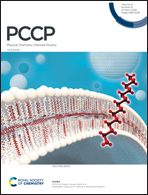Deterministic control of surface mounted metal–organic framework growth orientation on metallic and insulating surfaces†
Abstract
Surface-Mounted Metal–Organic Frameworks (SURMOFs) are promising materials with a wide range of applications and increasing interest in different technological fields. The use of SURMOFs as both the active and passive tail in electronic devices is one of the most exciting possibilities for such a hybrid material. In such a context, the adhesion, roughness, and crystallinity control of SURMOF thin films are challenging and have limited their application in new functional electronic devices. Self-assembled monolayers (SAMs), which ensure the effective attachment of the SURMOF onto substrates, also play a critical role that can profoundly affect the SURMOF growth mechanism. Herein, we demonstrate that the deterministic control of the SAM chain length influences the preferential orientation of SURMOF films. As the SAM chain length increases, HKUST-1 thin films tend to change their preferential orientation from the [111] towards the [100] direction. Such control can be achieved on both electrically conducting and insulating substrates, opening the possibility of having the very same preferential crystalline orientation on surfaces of different nature, which is of fundamental importance for SURMOF-based functional electronic devices.



 Please wait while we load your content...
Please wait while we load your content...